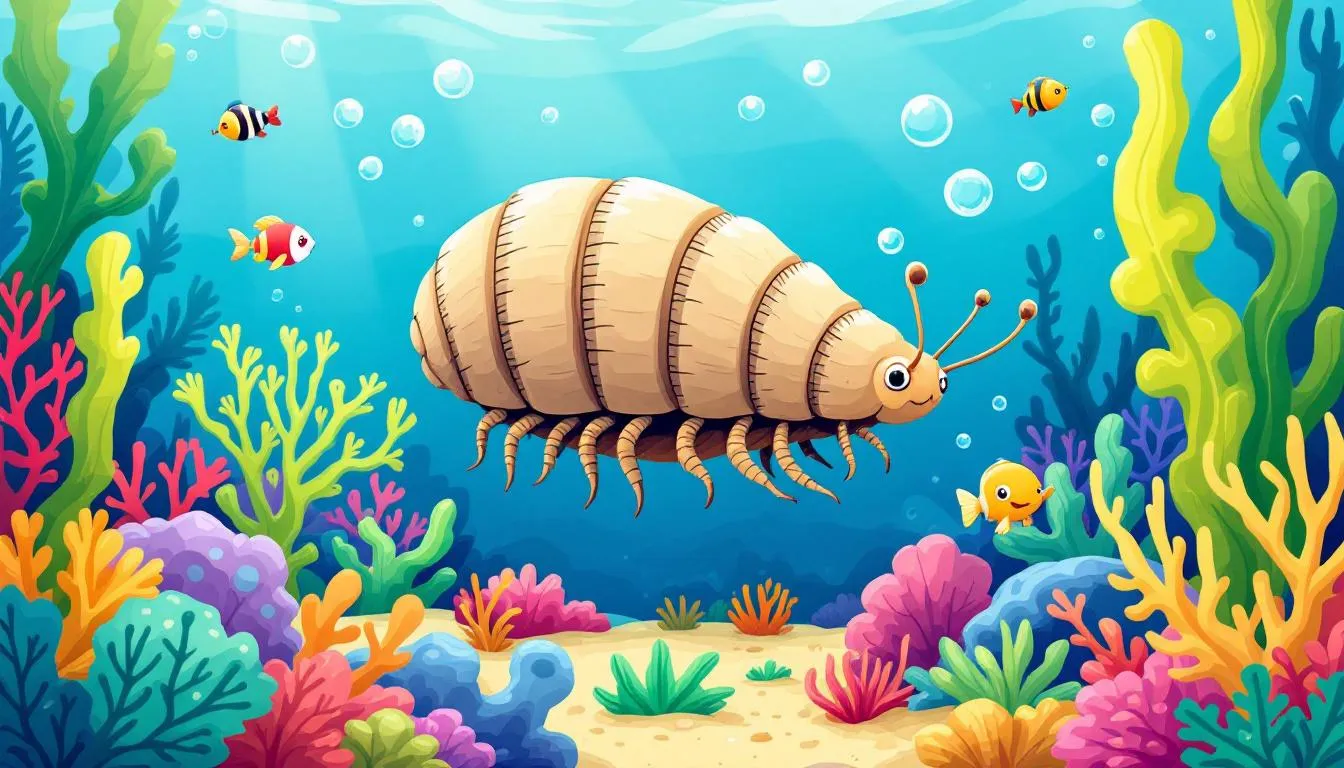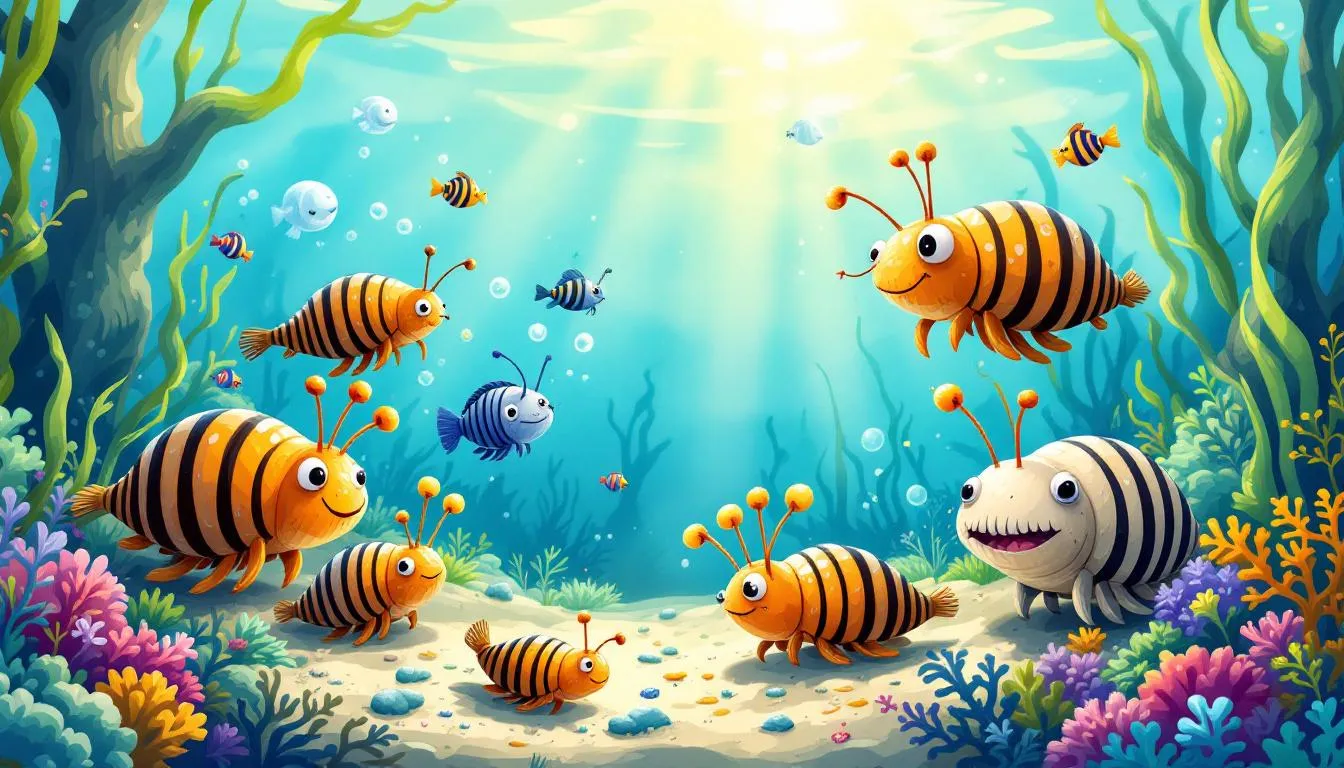Can Woodlice Swim? Discover the Truth About These Garden Pests
Can woodlice swim? No, they can’t. These land-dwelling crustaceans prefer moist environments but lack the adaptations to swim. In this article, we will explore their anatomy, amphibious relatives, and why they’re built for life on land, not water.
Key Takeaways
-
Woodlice can’t swim; they’re primarily terrestrial and prefer damp environments but lack swimming adaptations.
-
While mostly land-dwellers, some woodlice species can live both in water and on land, showcasing their adaptability.
-
Woodlice play a key role in gardens, breaking down dead plant matter and helping with nutrient cycling, though they can sometimes damage seedlings.
Understanding Woodlice Anatomy

Woodlice, including the common rough woodlouse and the rather grumpy woodlouse, possess a distinctive flattened body that makes them well-suited for life in tight spaces under rocks and logs. This body structure aids their movement and helps them blend into their surroundings, providing protection from predators.
Their exoskeleton is segmented into overlapping plates, providing both flexibility and protection. This ingenious design allows them to curl up into a ball when threatened, a behavior particularly common in the pill bug species, pill bugs, and armadillo bugs. The hard shell of these creatures plays a crucial role in their defense mechanisms against insects and bacteria.
Each woodlouse has two main body segments, the pereon (thorax) and the pleon (abdomen), with the pereon consisting of seven segments, each bearing a pair of legs, totaling seven pairs of legs. These wood legs allow them to navigate through various terrains in search of food and shelter.
The combination of their segmented exoskeleton and multiple legs makes them highly adaptable to their terrestrial lifestyle.
Moisture and Respiration in Woodlice
Woodlice are truly fascinating when it comes to their need for moisture. A humid environment is crucial for their survival, as they absorb moisture from the air to stay hydrated. Without adequate humidity, their respiratory efficiency declines, affecting their overall health.
These creatures extract oxygen primarily through their skin in moist environments. This process involves:
-
The diffusion of oxygen and carbon dioxide through their thin ventral integument.
-
Breathing through gills located on their hind legs.
-
The gills must remain moist for effective oxygen absorption, as moist tubes extract oxygen.
Interestingly, woodlice expel waste primarily through gas exchange, releasing ammonia vapour rather than urinating. This adaptation not only conserves water but also suits their terrestrial lifestyle, where maintaining moisture is key to survival.
For woodlice, especially those in captivity, a humid habitat is crucial. Regularly misting their environment helps sustain the necessary humidity levels, keeping them healthy and active.
Aquatic Relatives: Crabs, Shrimp, and Lobsters
Did you know that woodlice are closely related to crabs, shrimp, and lobsters? These creatures all belong to the phylum Arthropoda, sharing a common ancestry. While most crustaceans are predominantly aquatic, woodlice have made a successful transition to terrestrial life.
Despite their terrestrial adaptations, woodlice still retain many characteristics of their aquatic relatives. For instance, both woodlice and crabs possess a hard exoskeleton. However, unlike their aquatic cousins, woodlice have adapted to live on land, thriving in moist environments to prevent desiccation.
Woodlice are more closely related to shrimp than to crabs, despite their different habitats. This relationship showcases the remarkable adaptability of crustaceans, enabling them to exploit a wide range of ecological niches.
Can Woodlice Swim?

Can woodlice swim? No, they cannot. Primarily terrestrial creatures, woodlice prefer damp environments but lack adaptations for swimming. Unlike their aquatic relatives, woodlice lack the necessary adaptations, such as streamlined bodies or swimming legs, to move effectively in water.
Although they can survive temporarily in very moist conditions, woodlice are not built for an aquatic lifestyle. They thrive on the ground, seeking out damp, dark places.
Amphibious Species
While most woodlice are decidedly terrestrial, some species have adapted to amphibious lifestyles. For instance, Ligia oceanica, also known as the sea slater, can live both on land and in water, showcasing their amphibious nature. These species have pleopods functioning like gills, enabling them to breathe underwater.
Certain species, such as those in the Haloniscus genus from Australia, are known for their ability to survive in semi-aquatic habitats. Other examples include Typhlotricholigoides aquaticus and Cantabroniscus primitivus, both of which have developed unique adaptations for living in or near water.
These amphibious woodlice showcase the remarkable adaptability of isopods, enabling them to exploit diverse environments beyond terrestrial habitats.
Evolutionary History and Adaptations
The evolutionary journey of woodlice is a tale of remarkable adaptation. Originating from marine isopods, woodlice transitioned to terrestrial life during the Carboniferous period. This transition allowed them to exploit new ecological niches, leading to their diversification before the breakup of the supercontinent Pangaea.
Woodlice are one of the few crustacean lineages that have fully adapted to life on land. Their ability to thrive in diverse environments, from deserts to high altitudes, is a testament to their evolutionary success.
The evolution of amphibious woodlice is significant, showcasing their ability to inhabit both terrestrial and aquatic environments. This adaptability has enabled them to become one of the most widespread and successful groups of crustaceans.
Woodlice in Gardens and Homes

In gardens, woodlice play a vital role as detritivores, consuming dead plant matter and rotting vegetation to feed, contributing to nutrients cycling. They are often found in dark, damp areas like compost heaps, where they thrive on decaying organic material.
While generally harmless to healthy plants, woodlice may occasionally cause minor damage to soft plant tissues like seedlings. However, their overall contribution to garden ecosystems is largely beneficial.
Although they occasionally enter homes, woodlice prefer outdoor environments and struggle to survive in dry indoor conditions. Their presence usually indicates a nearby damp environment.
Woodlice as Pets

Keeping woodlice as pets has become increasingly popular among enthusiasts. Common species kept as pets include Armadillidiidae, often referred to as pillbugs or roly-polies. These creatures, including a few woodlice, are easy to care for and require a humid environment and a diet of decomposing plant matter to thrive.
Woodlice are fascinating pets due to their unique behaviors and low maintenance requirements. They can thrive in groups and are sometimes kept in terrariums, providing an interesting glimpse into the world of these small animals crustaceans.
Interesting Facts About Woodlice

Woodlice have several intriguing traits. For instance, they excrete ammonia gas through their exoskeleton instead of urinating, which produces a strong odor. This adaptation helps them conserve water, essential for their terrestrial lifestyle.
Another interesting fact is that woodlice are generally unpalatable due to their high uric acid levels, which may deter predators. With between 5,000 to 7,000 species globally, woodlice have numerous common names across different cultures, reflecting their widespread presence.
Summary
Woodlice are fascinating creatures that play crucial roles in their ecosystems. From their unique anatomy and respiratory adaptations to their evolutionary history and contributions to gardens, woodlice are much more than just garden pests. Although they cannot swim, certain species have adapted to amphibious lifestyles, showcasing their remarkable adaptability.
Understanding woodlice helps us appreciate the complexity of these small creatures and their importance in the natural world. So, next time you encounter a rather grumpy woodlouse in your garden, remember the incredible journey these little crustaceans have made from sea to land.
Frequently Asked Questions
Can woodlice swim?
Woodlice can’t swim; they’re more at home in damp places on land. So if you see one in water, it’s not going to have a good time!
Why do woodlice need moisture?
Woodlice need moisture because it helps them breathe through their gills and stay healthy. Without enough humidity, they can dry out and struggle to survive.
Are woodlice harmful to gardens?
Woodlice are mostly good for your garden since they help break down organic matter, but they can sometimes munch on seedlings. So, keep an eye on your young plants!
Can woodlice be kept as pets?
Totally, you can keep woodlice as pets! Just make sure to provide a humid environment and plenty of decomposing plant matter for them to munch on.
How do woodlice expel waste?
Woodlice get rid of waste by releasing ammonia vapor, rather than urinating like many other animals. So, they’ve got a pretty unique way of handling their waste!









